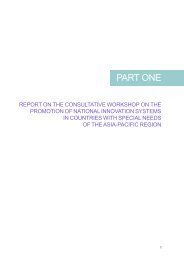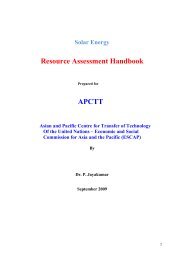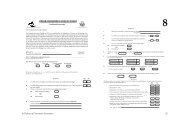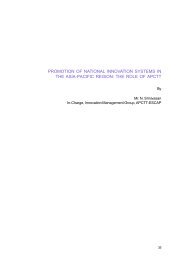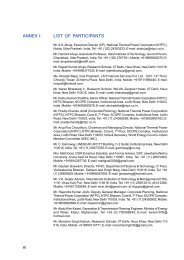Five principle sectors in the IT industry, namely online businesses, IT services, ITenabled services, and software and hardware merchandise received most of theinvestments. Compelling cost advantage, coupled with available skilled workforce, hasdriven this growth.Key government initiatives – such as setting up of tax free zones, Software TechnologyParks of India (STPI) and Special Economic Zones (SEZ) – have given strong impetusto the export of IT services by exempting companies from a variety of taxes during thesetting up and the initial years of operations. India is still developing its attractivenessfor strategic operations, such as R&D centres and headquarters. In 2011, investorsonly brought 20 R&D centres to India and 13 headquarters. R&D is the most attractivestrategic function in India. However, in 2011, the country only gained 20 such projectsor 2 per cent of the total FDI projects. This is mainly because of the lack of sufficienttraining centres and vocational training courses in the country. In addition, there is aneed to make India’s current intellectual property systems more inclusive and safe,and to enable investors to access the system at low or subsidized costs.4. Three elements of concernThere are three aspects that are critical to India’s ability to attract investments into itsindustries. One is that the investors want to secure their investments in easily accessibleand predictable business climates with FDI-friendly regulatory environments. Theprospective investors also need a better business environment, with improvedinfrastructure network and better governance and transparency in system. India alsoneeds to foster an innovation-led culture that is needed to improve the quality of itslaboratories in research institutions and corporations, which would otherwise be aroadblock to developing new products in the country.IISTATUS OF ADVANCED FOSSIL FUEL-BASED ELECTRICITYGENERATIONA. Electric power sector: current statusThe status of electric power generation in the country as on 31 March 2012 in terms ofinstalled generation capacity and electricity target and achievement as reported byCEA is reflected in Tables 2-4 and 2-5:Table 2-4: Installed generation capacity (MW, as on 31.03.2012) (Utilities)All India Thermal Nuclear Hydro RES* Grand totalCoal Gas Diesel TotalCapacity 112,022.38 18,381.05 1,199.75 131,603.18 4,780.00 38,990.40 24,503.45 199,877.03Percentage 56.0 9.2 0.6 65.8 2.4 19.5 12.3 100.0Notes:RES – Renewable energy sources, includes small hydro projects, biomass gas, biomass power, urban & industrial waste power,wind energy and solar power.* Data from the Ministry of New and Renewable Energy (MNRE).(Source: Central Electricity Authority, May 2012)60
Table 2-5: Electricity generation target/achievement (2011-12) (Utilities only)Hydro Thermal Nuclear Imported* TotalTarget(Million units) 112,050.00 712,234.00 25,130.00 5,586.00 855,000.00Achievement (up to 31.03.12)(Million units) 130,511.50 708,805.94 32,286.56 5,284.51 876,888.48Percentage 116.48 99.52 128.48 94.60 102.56Note: * From BhutanSource: Central Electricity Authority, May 2012The captive generation capacity in industries having demand of 1 MW and above, gridinteractive (non-utilities) as on 31.03.2012 was 31,516.87 MW, while the total installedgeneration capacity in the country was 231393.90 MW.Electricity generation in the year 2011-12 (provisional up to 31 March 2012) was 876.88billion units as given in Table 2-5. The All India annual per capita consumption ofelectricity during the year 2010-11 was 813.3 kWh.It may be mentioned that currently, none of the coal-based thermal plants in India is ofsupercritical category.B. FDI into the power sectorAutomatic approval (Reserve Bank of India Rule) for 100 per cent foreign equity ispermitted in generation, transmission and distribution and trading in the power sectorwithout any upper sealing on the quantum of investment.The power sector was the first to be liberalized, allowing FDI in power generation sincethe mid-1990s. FDI inflow, however, picked up only during 2008-09 (US$985 million),2009-10 (US$1,437 million) and 2010-11 (US$1,252 million), taking the cumulativetotal since April 2000 to US$5,900 million.C. Regulatory environmentThe Central Electricity Regulatory Commission (CERC) is an independent statutorybody with quasi-judicial powers. It was constituted on 25 July 1998 under the ElectricityRegulatory Commission Act, 1998 and has been continued under Electricity Act, 2003.The regulatory functions of CERC include:• Tariff regulation;• Regulation of inter-state transmission of electricity;• Granting licence for inter-state transmission and inter-state trading in electricity;• Adjudication of disputes;• Specifying grid code;• Specifying and enforcing the standards with respect to quality, continuity andreliability of service by licensees; and61
- Page 1 and 2:
ADVANCES IN FOSSIL FUELTECHNOLOGIES
- Page 3 and 4:
ADVANCES IN FOSSIL FUELTECHNOLOGIES
- Page 5 and 6:
CONTENTSABBREVIATIONSiiiPART ONEREP
- Page 7 and 8:
ABBREVIATIONSAC : Alternating curre
- Page 9:
OECD : Organization for Economic Co
- Page 12 and 13:
IORGANIZATION OF THE WORKSHOPA. Bac
- Page 14 and 15:
D. Election of officersThe followin
- Page 16 and 17:
IIICONSIDERATION OF ISSUESA. Backgr
- Page 18 and 19:
emissions. Underground coal gasific
- Page 20 and 21: 800 MWe, a steam pressure of 300 kg
- Page 22 and 23: • Materials development & manufac
- Page 24 and 25: Figure 1-5: Strategy for commercial
- Page 26 and 27: tonnes, the state-owned enterprise
- Page 28 and 29: • Ensuring not just easy FDI entr
- Page 30 and 31: MW ultra-supercritical units; and s
- Page 32 and 33: the captive generation capacity) on
- Page 34 and 35: and other financial institutions -
- Page 36 and 37: and higher efficiency power generat
- Page 38 and 39: energy technologies, which can enab
- Page 40 and 41: • Such massive financial inputs c
- Page 43 and 44: BASELINE REPORT ON FOSSIL FUEL TECH
- Page 45 and 46: B. General R&D climate in the count
- Page 47 and 48: a convenient way to envisage energy
- Page 49 and 50: to mature and become more cost-comp
- Page 51 and 52: emissions, at least relative to sin
- Page 53 and 54: The Ministry of Power (MoP), which
- Page 55 and 56: 3. Bio-energyBio-energy, widely ava
- Page 57 and 58: in such a canal will rotate at a lo
- Page 59 and 60: in tackling climate change. A one p
- Page 61 and 62: Advantages of supercritical plants
- Page 63 and 64: existing power plants but also to b
- Page 65 and 66: BASELINE REPORT ON FOREIGN DIRECT I
- Page 67 and 68: CEA at 598 mt. This is mainly due t
- Page 69: For India to maintain its momentum
- Page 73 and 74: Growth, which submitted its interim
- Page 75 and 76: 3. Future challengesThe future chal
- Page 77 and 78: development worked out. Public-priv
- Page 79 and 80: Linking FDI to technology transferI
- Page 81 and 82: The total requirement of fund durin
- Page 83 and 84: Funding from multilateral agenciesM
- Page 85 and 86: cooperation will be essential in so
- Page 87: Planning Commission, Government of
- Page 90 and 91: ANNEX I:LIST OF PARTICIPANTSMr. A.K
- Page 92 and 93: Mr. S.C. Shrivastava, Joint Chief (
- Page 94 and 95: ANNEX II:PROGRAMME6 June 2012, Wedn
- Page 96 and 97: ANNEX III:AN OVERVIEW OF ADVANCED F
- Page 98 and 99: • Technology solutions are also v
- Page 100 and 101: Table 3-5: Improvement in cycle eff
- Page 102 and 103: • No liquid effluent formation;
- Page 104 and 105: Figure 3-5: Advancement of gas turb
- Page 106 and 107: Figure 3-8: Goal 2 - New clean tech
- Page 108 and 109: Compared with conventional power pl
- Page 110 and 111: Figure 3-14: Thermax coal gasificat
- Page 112 and 113: ANNEX VII:GE ENERGY AND ADVANCED FO
- Page 114 and 115: ANNEX VIII:SWOT ANALYSIS OF FOSSIL
- Page 116 and 117: By 2035, cumulative CO 2emissions f
- Page 118 and 119: • Falling prices of renewable ene
- Page 120 and 121:
Figure 3-20: New advanced coal powe
- Page 122 and 123:
ANNEX X:ENERGY CONSERVATION: ERDA
- Page 124 and 125:
Table 3-11: Energy cost and intensi
- Page 126 and 127:
300Figure 3-23: Trends in coal use
- Page 128 and 129:
C. Gaps in coal use efficiencyFigur
- Page 130 and 131:
ANNEX XII:FINANCING OF THE POWER SE
- Page 132 and 133:
With the entry of many private sect
- Page 134 and 135:
for future requirements should be t
- Page 136 and 137:
Short supply of coal has started af
- Page 138:
Figure 3-35: Life-cycle of technolo



